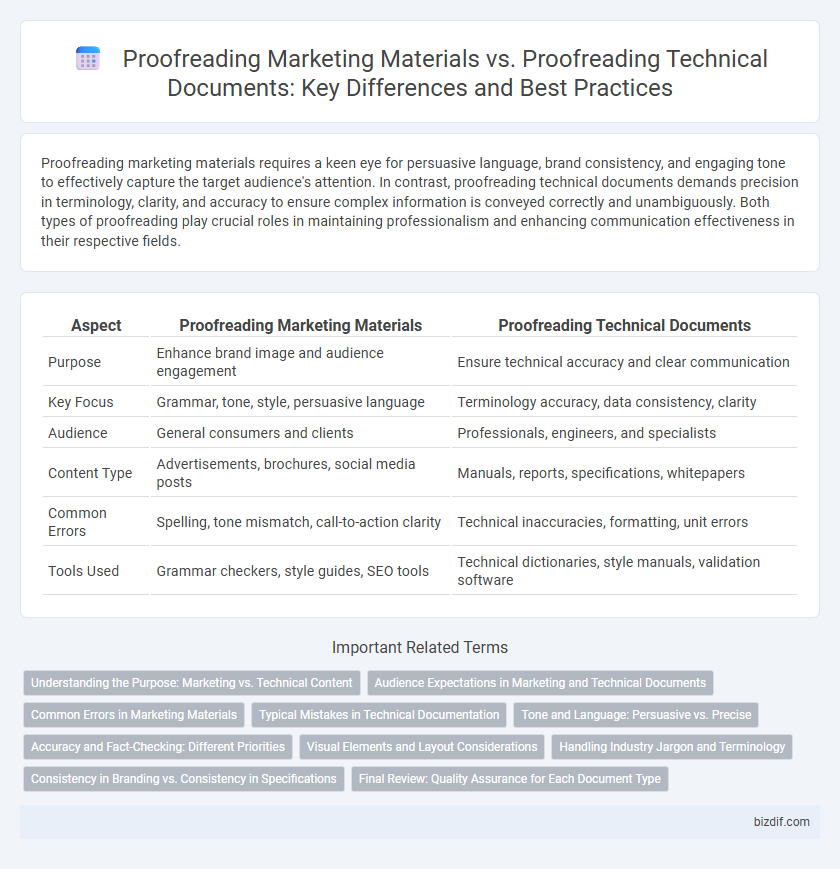Proofreading marketing materials requires a keen eye for persuasive language, brand consistency, and engaging tone to effectively capture the target audience's attention. In contrast, proofreading technical documents demands precision in terminology, clarity, and accuracy to ensure complex information is conveyed correctly and unambiguously. Both types of proofreading play crucial roles in maintaining professionalism and enhancing communication effectiveness in their respective fields.
Table of Comparison
| Aspect | Proofreading Marketing Materials | Proofreading Technical Documents |
|---|---|---|
| Purpose | Enhance brand image and audience engagement | Ensure technical accuracy and clear communication |
| Key Focus | Grammar, tone, style, persuasive language | Terminology accuracy, data consistency, clarity |
| Audience | General consumers and clients | Professionals, engineers, and specialists |
| Content Type | Advertisements, brochures, social media posts | Manuals, reports, specifications, whitepapers |
| Common Errors | Spelling, tone mismatch, call-to-action clarity | Technical inaccuracies, formatting, unit errors |
| Tools Used | Grammar checkers, style guides, SEO tools | Technical dictionaries, style manuals, validation software |
Understanding the Purpose: Marketing vs. Technical Content
Proofreading marketing materials requires a focus on clarity, persuasion, and brand voice consistency to effectively engage the target audience and drive action, whereas proofreading technical documents demands precision, accuracy, and adherence to industry-specific terminology to ensure clear communication of complex information. Marketing content aims to attract and motivate potential customers, often using emotional appeal and concise language, while technical content prioritizes detailed explanations, factual correctness, and logical flow to support comprehension and usability. Understanding these distinct purposes guides proofreaders in applying the appropriate strategies, tone, and attention to detail for each type of content.
Audience Expectations in Marketing and Technical Documents
Proofreading marketing materials requires a focus on clear, persuasive language that resonates with a broad audience, ensuring brand consistency and emotional appeal. Technical documents demand precise terminology, accuracy, and clarity to meet the expectations of industry professionals who rely on detailed information for decision-making. Understanding these audience expectations is critical to tailoring the proofreading approach for effective communication.
Common Errors in Marketing Materials
Common errors in proofreading marketing materials include inconsistent brand messaging, improper tone, and typographical mistakes that can undermine audience engagement. Spelling errors in product names and incorrect use of jargon are frequent issues that affect credibility and consumer trust. Ensuring alignment with marketing strategies while maintaining clarity and creativity is crucial for effective communication in promotional content.
Typical Mistakes in Technical Documentation
Typical mistakes in technical documentation include inconsistent terminology, unclear instructions, and formatting errors that hinder user comprehension. Proofreading technical documents requires specialized attention to accuracy in technical terms, standards, and compliance with industry guidelines. Unlike marketing materials, these documents demand precise verification to avoid costly misinterpretations and ensure clarity for technical audiences.
Tone and Language: Persuasive vs. Precise
Proofreading marketing materials demands a persuasive tone and engaging language that appeals to target audiences and drives action. In contrast, proofreading technical documents requires precise language and a formal tone to ensure clarity, accuracy, and unambiguous communication of complex information. Tailoring the proofreading approach to suit the document type enhances both effectiveness and readability.
Accuracy and Fact-Checking: Different Priorities
Proofreading marketing materials emphasizes persuasive language and brand consistency, requiring careful attention to tone and style accuracy to engage target audiences effectively. In contrast, proofreading technical documents prioritizes precision in terminology, numerical data, and factual correctness, ensuring compliance with industry standards and preventing costly errors. Accuracy in marketing enhances consumer trust, while fact-checking in technical content safeguards reliability and operational safety.
Visual Elements and Layout Considerations
Proofreading marketing materials requires meticulous attention to visual elements such as font styles, colors, and imagery alignment to ensure brand consistency and appeal. In contrast, proofreading technical documents prioritizes clear layout structure, including headings, bullet points, and spacing, to enhance readability and comprehension for specialized audiences. Both processes involve verifying that visual presentation supports the content's purpose without distracting or confusing the reader.
Handling Industry Jargon and Terminology
Proofreading marketing materials requires careful attention to industry jargon to ensure the language remains engaging and accessible to the target audience without compromising brand voice. In contrast, proofreading technical documents demands precise handling of specialized terminology to maintain accuracy and clarity vital for expert readers. Mastery of industry-specific vocabulary in both contexts enhances the effectiveness and professionalism of the final text.
Consistency in Branding vs. Consistency in Specifications
Proofreading marketing materials demands strict consistency in branding elements such as logos, taglines, and tone to maintain a cohesive brand identity across all platforms. In contrast, proofreading technical documents requires precise consistency in specifications, terminology, and data accuracy to ensure clear communication and prevent costly errors. Both types of proofreading play crucial roles in upholding a company's professional image but target different aspects of content integrity.
Final Review: Quality Assurance for Each Document Type
Final review for proofreading marketing materials emphasizes clarity, brand consistency, and persuasive language to ensure a compelling message that resonates with target audiences. In contrast, proofreading technical documents prioritizes accuracy, adherence to industry standards, and terminological precision to guarantee reliability and prevent misinterpretation. Quality assurance in both cases requires tailored checklists and expert reviewers specialized in the respective content fields.
Proofreading Marketing Materials vs Proofreading Technical Documents Infographic

 bizdif.com
bizdif.com